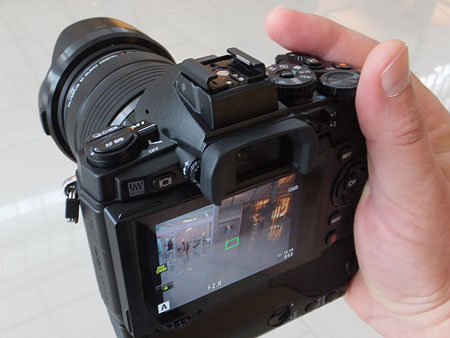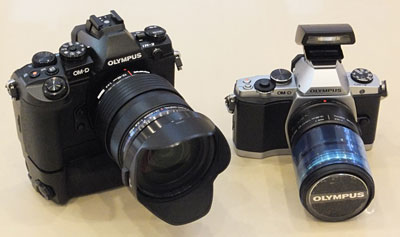Here some quick first impressions after I played bit with the Olympus OM-D E-M1. Talk evolution rather than revolution. While the body is slightly larger than that of the original OM-D, the E-M5, it doesn’t feel that much bigger. With the battery grip and 12-40mm F2.8 attached it’s a comfortable package. Less stylish than it’s predecessor and apart from the looks an all along faster, better, more advanced successor. But if the E-M5 wasn’t right up your alley in terms of ergonomics, the E-M1 is not a completely different beast. Personally, I don’t want this newest OM-D a millimeter larger. But if size matters to you, this slightly more futuristic looking OM-D is just another rock solid OM-D, and a very impressive one for that.
And beware, not all that shines is gold. Alongside the E-M1 I played as well a bit with Panasonic’s new Lumix GX7. While the Lumix’ design is much less spectacular, I must say the Panasonic felt more comfortable, more intuitive, more natural in my hands. This E-M1 sports some bold design and might not satisfy everyone’s taste and needs. It does, however, mine. The Lumix is just very different. Less loud, more classic.

Add the exceptionally big and bright viewfinder. What a pleasure. You still can tell it’s not an optical VF, but the hints of lag and minimal flicker in dim light don’t obstruct the kind of F2-Titanesque experience.
Plus: the kit lens. This 12-40mm F2.8 might be a reason for many to switch to the Olympus camp. Not only the metallic build quality of these “pro” optics feels excellent. The bokeh is smooth and buttery with only a slight hint of nervousness. It’s no Leica Lux glass, but in a very compact package you get an all-rounder that could well replace a whole DSLR lensarium…
Below are some straight out of camera JPEG and ORF files in full resolution for you to download and play with.
To challenge the combo a bit more and test corner performance, the zoom is wide open. All settings ex factory with AWB, handheld, no distortion correction and firmware 1.0 of a production E-M1.

For now, my head wants the Oly, the heart likes the Pana. Has to be seen whether this still is the case after I compare the files. And is the E-M1 another Olympus marketing hype? Yet again, as with every major announcement, Olympus is praising this camera’s “world’s fastest” and “fastest ever” AF system. To be taken with a grain of salt? In the past such promises didn’t really live up to expectations raised. We’ll see about that.
Still, considering the size of the sensor, this E-M1 output is pretty impressive, to say the least. Who says bigger is always better?
Below are first two portrait samples, then the uncropped ISO comparison test scene followed by 100% crops of each ISO step.
BTW, why I chose a well-lit scene? It’s a common misconception that dimmer light shows more noise. The intensity of light is irrelevant to the amount of noise. The reason why dim light shows more noise than bright sunlight is simple: it’s not the intensity of light, photos taken in dim light tend to be underexposed to a greater extent than those in good light.
It’s maybe a matter of taste, but in good light noise-related problems and artifacts, aliasing and other typical issues that arise in digital cameras images seem more pronounced.
Anyways, E-M1 conclusion for now:
The E-M1 is a true flagship camera.
For Olympus.
Don’t know yet if for me.
No, they don’t give me any free lunch. I get loaners, that’s it.
But they always have these huge claims. Fastest, bestest, whatever.
As said, AWB wasn’t very spot on in difficult light.
But in a very compact package you get an overall class leading performance that questions whether sensor equivalence matters any longer.
The E-M5 already was a stellar camera. The E-M1 gives you an improved, already unmatched 5-axis stabilization, an improved 16.3MP sensor (glad they don’t cramp in more pixels), better customization, improved handling, Titanesque viewfinder, etc.
So far the E-M1 excites me very much. But as ergonomics, mojo and overall feel are as least as important as technicalities, I have to put this combo to the test first.
Today nearly every camera is able to offer good performance in capable hands. Whether a camera is “good” or not depends more than ever on individual preferences and needs.
Must admit, I love Olympus. But not to the point to whore for them. Loved the E-1 with it’s CCD Kodak sensor and may have made a mistake by selling it. I’m sure that camera could still perform reasonably well today.
The E-3 was a disappointment.
The E-M1 looks very promising. As said, Olympus is good in making huge marketing promises. Not that the camera is a total breakthrough, but another OM-D engineering marvel that certainly solidifies Olympus’ position and draws more well-deserved attention to maturing Micro Four Thirds.
For full resolution JPEG downloads click the cropped image. For RAW downloads click “Download ORF” in the respective caption box.
+++ You can order the Olympus OM-D E-M1 and the new fast 12-40mm F2.8 PRO zoom from Amazon (dedicated page/body/lens), B&H (body/lens) and Adorama (body/lens).



Now here the successive ISO sample crops:















+++ You can order the Olympus OM-D E-M1 and the new fast 12-40mm F2.8 PRO zoom from Amazon (dedicated page/body/lens), B&H (body/lens) and Adorama (body/lens).


